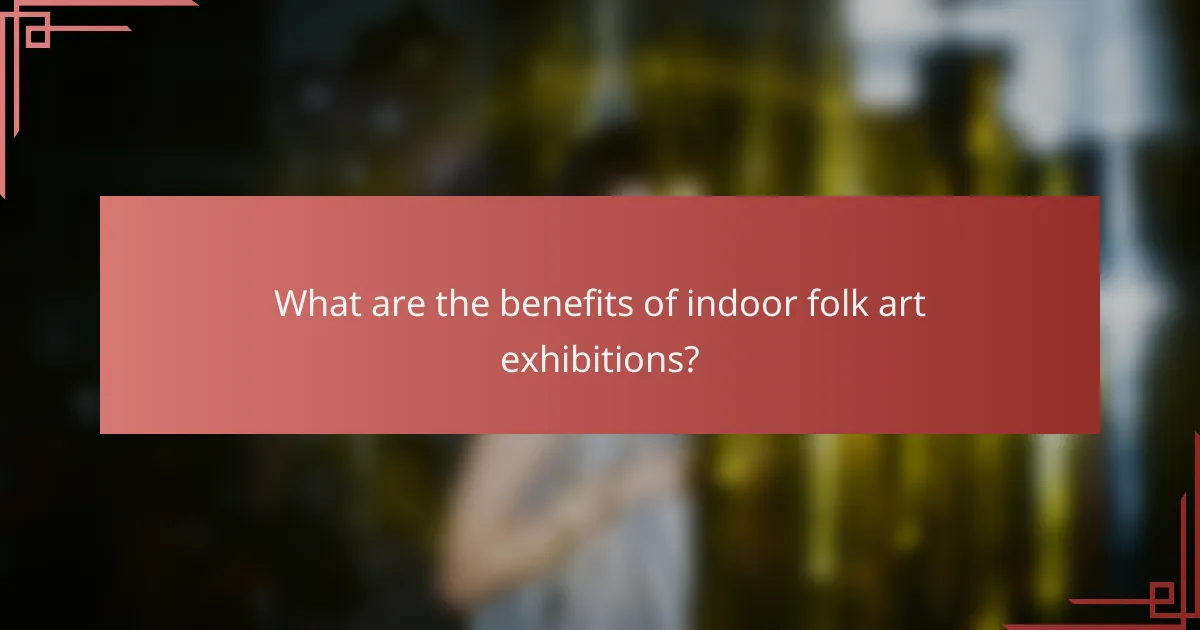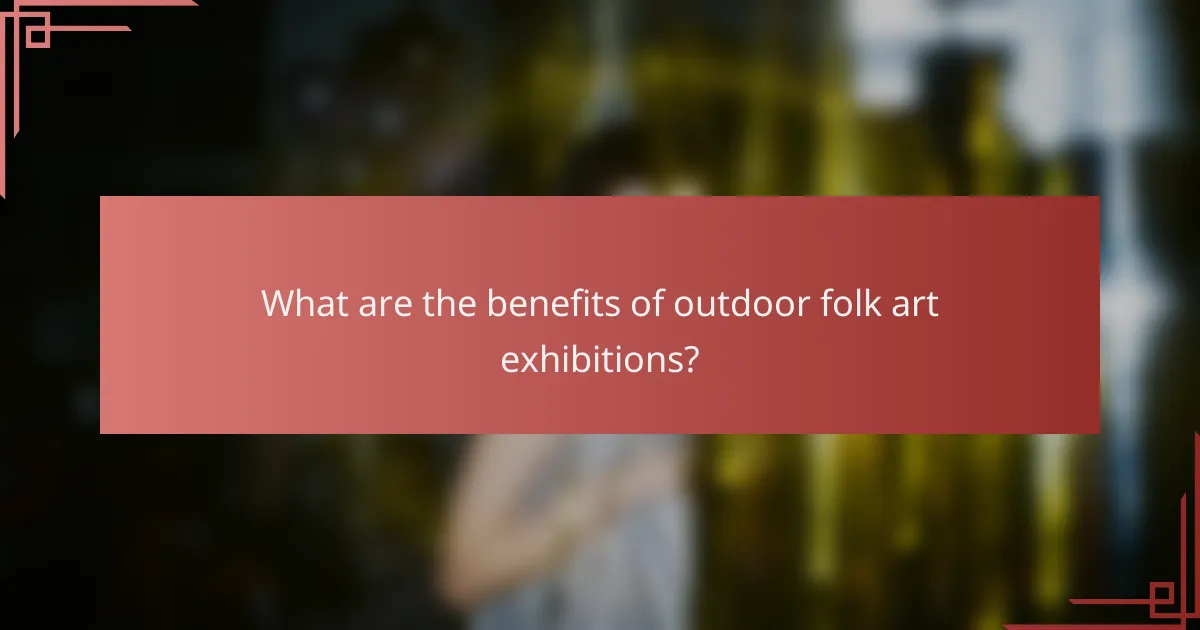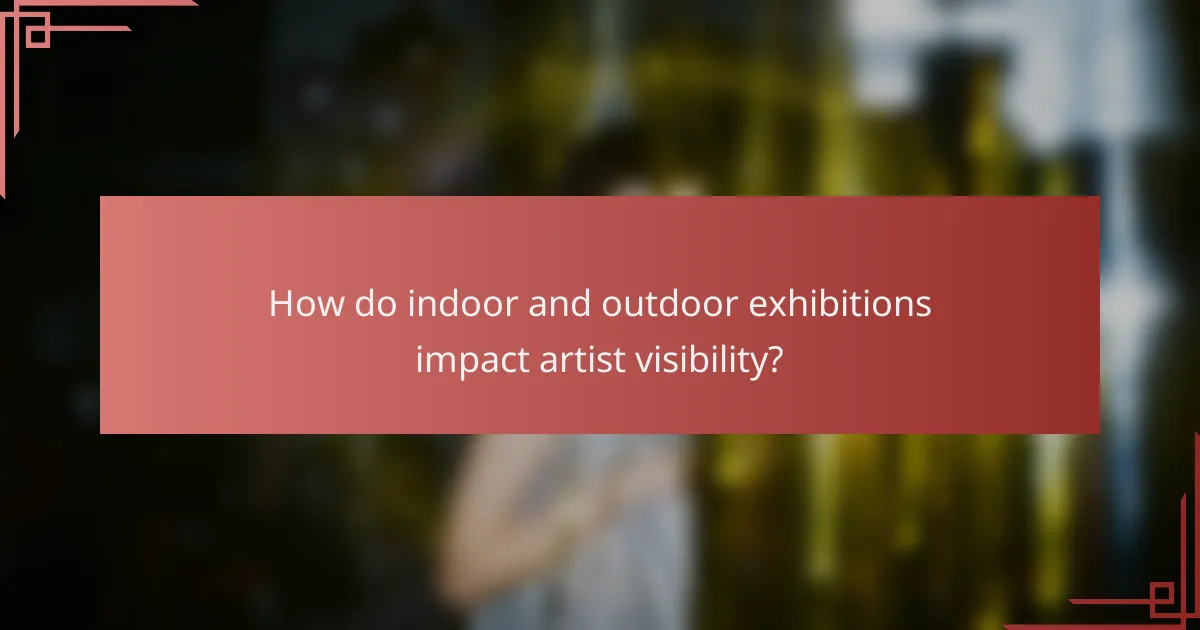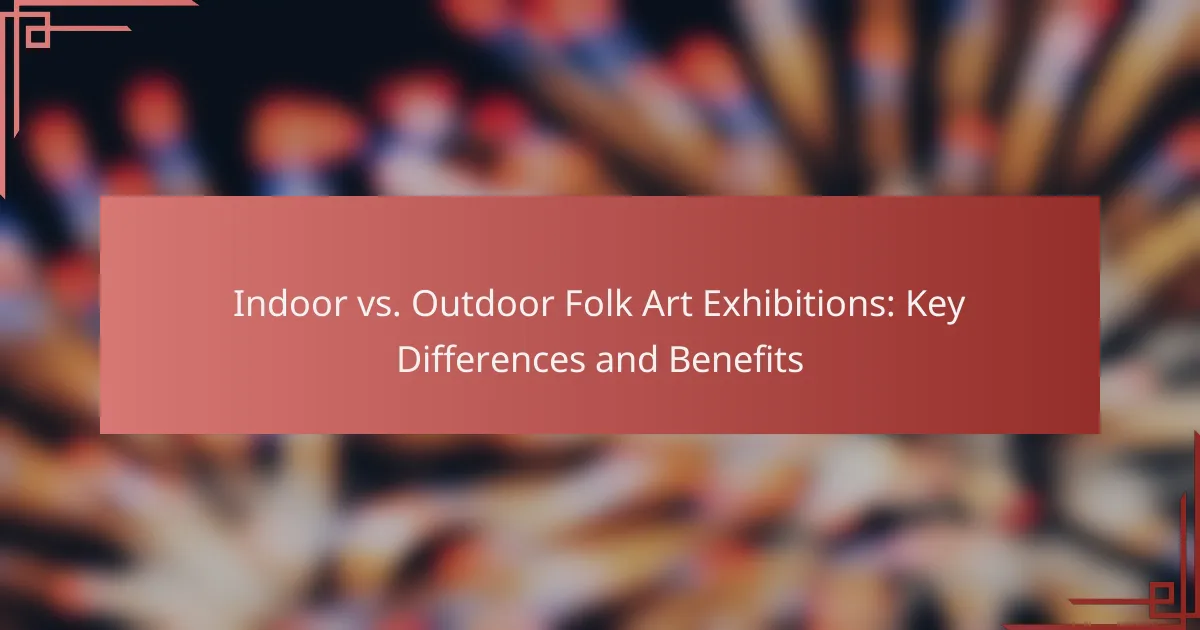Indoor and outdoor folk art exhibitions present distinct experiences shaped by their environments and accessibility. While indoor settings provide better preservation and comfort, outdoor exhibitions leverage natural surroundings to foster community engagement and a lively atmosphere. Understanding these differences can enhance appreciation for the unique benefits each format offers to artists and audiences alike.

What are the key differences between indoor and outdoor folk art exhibitions?
Indoor and outdoor folk art exhibitions differ primarily in their space, accessibility, and environmental factors. Each setting offers unique advantages and challenges that can significantly influence the visitor experience and the preservation of the artworks displayed.
Space and environment
Indoor exhibitions typically provide controlled environments that can enhance the viewing experience. They often feature lighting and temperature regulation, which can highlight the details of the artwork. In contrast, outdoor exhibitions utilize natural landscapes, which can create a more immersive experience but may lack the same level of control over lighting and ambiance.
Additionally, indoor spaces can accommodate larger crowds comfortably, while outdoor venues may require more planning for layout and flow due to varying terrain and weather conditions.
Accessibility and visitor experience
Indoor folk art exhibitions generally offer better accessibility for individuals with mobility challenges, as they often include ramps and elevators. Outdoor exhibitions, while potentially more scenic, may present obstacles such as uneven ground or limited seating areas.
Visitor experience can vary significantly; indoor settings may allow for more intimate interactions with the art, while outdoor exhibitions can engage visitors with the surrounding environment, offering a different sensory experience.
Weather impact
Weather plays a crucial role in outdoor folk art exhibitions, as rain, wind, or extreme temperatures can disrupt events and affect attendance. Organizers must plan for contingencies, such as providing tents or alternative indoor spaces.
Indoor exhibitions are insulated from weather-related issues, allowing for consistent attendance and a stable environment for both the artworks and visitors.
Art preservation considerations
Preserving folk art is a critical concern in both settings. Indoor exhibitions can provide a stable climate that protects artworks from humidity and temperature fluctuations, which are detrimental to many materials.
Outdoor exhibitions, however, expose art to the elements, necessitating the use of weather-resistant materials and protective measures to ensure the longevity of the pieces displayed.
Exhibition duration
Indoor exhibitions can typically run for longer periods due to the controlled environment, allowing for extended engagement with the art. They can last from weeks to several months, depending on the venue and the artwork.
Outdoor exhibitions, on the other hand, are often seasonal and may only be feasible during certain months, limiting their duration. This can create a sense of urgency for visitors to attend before the exhibition closes.

What are the benefits of indoor folk art exhibitions?
Indoor folk art exhibitions offer several advantages, including better preservation of artworks, enhanced visitor comfort, and year-round accessibility. These benefits create a more engaging experience for both artists and attendees.
Controlled climate for art preservation
Indoor venues provide a controlled climate that helps preserve the integrity of folk art. Temperature and humidity levels can be monitored and adjusted to prevent damage from environmental factors like sunlight, moisture, and temperature fluctuations.
This controlled environment is crucial for delicate materials, such as textiles and wood, which can deteriorate quickly if exposed to harsh conditions. By ensuring optimal preservation, indoor exhibitions can maintain the quality and longevity of the artworks displayed.
Enhanced visitor comfort
Indoor folk art exhibitions typically offer a more comfortable environment for visitors. Climate control means that attendees can enjoy the exhibition without being affected by extreme weather conditions, whether it’s heat, cold, or rain.
Comfortable seating areas and amenities, such as restrooms and cafes, can also enhance the overall experience. This encourages longer visits and allows guests to engage more deeply with the art and the stories behind it.
Year-round accessibility
Indoor exhibitions can operate throughout the year, regardless of seasonal changes. This consistent availability allows more people to access folk art, as it is not limited by weather conditions or specific seasons.
Moreover, indoor venues can host events and workshops that promote folk art culture, further increasing community engagement. This accessibility is particularly beneficial in regions where outdoor exhibitions may be impractical for several months due to climate constraints.
Curated experiences
Indoor folk art exhibitions often feature curated experiences that guide visitors through the art on display. Curators can design thematic exhibitions that tell a story or highlight specific cultural aspects, enhancing the educational value of the visit.
These curated experiences can include guided tours, interactive displays, and artist talks, providing deeper insights into the artworks and their cultural significance. Such programming fosters a richer understanding and appreciation of folk art among attendees.

What are the benefits of outdoor folk art exhibitions?
Outdoor folk art exhibitions offer unique advantages, including a natural setting that enhances the viewing experience and opportunities for community involvement. These events can create a vibrant atmosphere that draws in larger crowds and fosters a sense of connection among attendees.
Natural ambiance and scenery
Outdoor exhibitions benefit from the inherent beauty of nature, which can enhance the overall experience for visitors. The combination of art and natural surroundings often creates a more relaxed and inviting atmosphere, encouraging attendees to linger and appreciate the works on display.
Additionally, the changing seasons can add a dynamic element to outdoor exhibitions. For instance, spring blossoms or autumn foliage can serve as a stunning backdrop, making the art more visually appealing and memorable.
Community engagement opportunities
Outdoor folk art exhibitions provide a platform for local artists to showcase their work, fostering community pride and support. These events often encourage participation from local organizations, schools, and businesses, creating a sense of ownership and collaboration among residents.
Moreover, outdoor settings facilitate interactive activities, such as workshops or live demonstrations, which can engage attendees of all ages. This hands-on approach not only enriches the experience but also helps build lasting connections within the community.
Space for larger installations
Outdoor venues typically offer more space than indoor galleries, allowing for larger installations and sculptures that may not fit in traditional settings. This openness can accommodate ambitious artworks that invite viewers to walk around and interact with them from different angles.
Artists can take advantage of this space to create immersive experiences, such as installations that incorporate natural elements or engage with the environment. This freedom can lead to innovative expressions of folk art that resonate more deeply with audiences.
Seasonal themes and events
Outdoor exhibitions can easily align with seasonal themes, making them more relevant and appealing to visitors. For example, summer festivals might feature vibrant colors and lively performances, while autumn events could focus on harvest motifs and community gatherings.
Additionally, hosting exhibitions during specific seasons can attract larger crowds, as people often seek outdoor activities during pleasant weather. This seasonal approach can enhance marketing efforts and create a more festive atmosphere, encouraging repeat visits and community participation.

How do indoor and outdoor exhibitions impact artist visibility?
Indoor and outdoor exhibitions significantly influence artist visibility by determining the audience’s engagement and the overall atmosphere. Indoor exhibitions often provide a controlled environment, while outdoor settings can attract larger, more diverse crowds, enhancing exposure for artists.
Audience reach variations
Indoor exhibitions typically cater to a specific audience, often those who are already interested in art or culture. This can limit reach to a few hundred or thousand visitors, depending on the venue size. In contrast, outdoor exhibitions can draw in passersby, potentially reaching thousands of attendees who may not have planned to engage with art, thus broadening the audience base.
Additionally, outdoor events may benefit from local foot traffic, especially in busy urban areas or during festivals, making them more accessible to a wider demographic. This increased visibility can lead to greater awareness of the artists and their work.
Networking opportunities
Networking opportunities differ greatly between indoor and outdoor exhibitions. Indoor settings often facilitate more intimate interactions, allowing artists to connect deeply with curators, critics, and collectors. This environment can foster meaningful conversations and collaborations.
On the other hand, outdoor exhibitions can create a more casual atmosphere where artists meet a diverse range of attendees, including casual art lovers and potential buyers. While these connections may be less formal, they can still lead to valuable relationships and future opportunities.
Sales potential differences
Sales potential can vary significantly between indoor and outdoor exhibitions. Indoor exhibitions often have a more curated selection, which can attract serious buyers willing to invest in art. Prices may be higher, reflecting the exclusivity and quality of the works presented.
Conversely, outdoor exhibitions may encourage impulse purchases due to their casual nature. Prices might be lower to appeal to a broader audience, leading to a higher volume of sales, albeit at potentially lower profit margins. Artists should consider their target market and sales strategy when choosing the type of exhibition to participate in.

What factors should be considered when choosing between indoor and outdoor exhibitions?
When deciding between indoor and outdoor folk art exhibitions, consider factors such as audience comfort, weather conditions, and space requirements. Each setting offers unique advantages and challenges that can significantly impact visitor experience and artwork presentation.
Target audience preferences
Understanding your target audience is crucial when selecting between indoor and outdoor exhibitions. Indoor exhibitions often appeal to those seeking a controlled environment, free from weather disruptions, while outdoor exhibitions attract visitors who enjoy nature and open spaces.
Consider conducting surveys or gathering feedback from past attendees to gauge preferences. For instance, families with young children might prefer indoor venues for safety and comfort, while art enthusiasts may appreciate the natural light and ambiance of outdoor settings.



